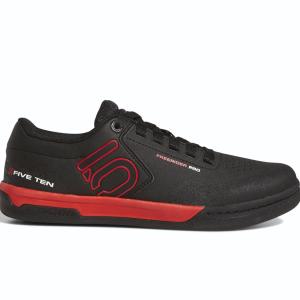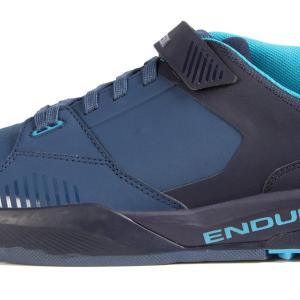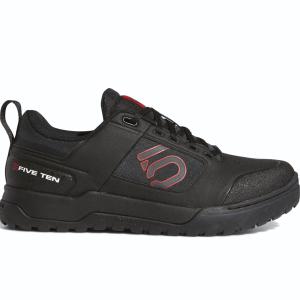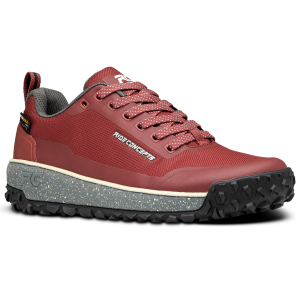Five Ten Freerider Contact Shoe
(discontinued)
| Where To Buy | |||
|---|---|---|---|
Free shipping on orders over $50 (continental U.S. only).
International shipping available. Some exclusions apply. |
|||
Free shipping on orders over $50 (continental U.S. only).
International shipping available. Some exclusions apply. |
|||
Review by Johan Hjord // Photos by Tal Rozow and Johan Hjord
Five Ten’s Stealth rubber is legendary among flat pedal riders, and with good reason. To this day, it remains what is widely considered to be the stickiest, grippiest sole option available short of clipping in. For a few years however, the only shoes available with this magic compound were slightly heavy and bulky items, often lacking a bit in finish and in the general level of construction of the shoe (if you’ve ever glued the outsole back onto your Impacts you know what we mean). Fast forward to present day, and there’s a multitude of options on offer from Five Ten, many of which are much more elaborate in terms of design. We’ve been testing the all-new Freerider Contact over the winter months, and we’re here to tell you how we got along.

Five Ten Freerider Contact Highlights
- Synthetic / Polyester textile with laces, stiff midsole, added toe protection, and contact outsole
- Stealth Mi6 rubber sole
- Sizes: 4-12, 13, 14 US Sizes
- Colors: Black/Lime Punch or Grey/Blue
- Weight: 0 lb 13.6 oz (385 g) (size 9 US)
- MSRP: $120.00
Initial Impressions
The Freerider Contact is aimed squarely at the “all mountain flat pedal” rider (it is an evolution of the Freerider VXi which was introduced a couple of years ago). It is far less bulky than the Impact (Five Ten’s heavy-hitting DH shoe), and it also features a sole which lacks any kind of tread pattern on the pedal contact patch. This deliberate de-tuning of the grip was done to allow the rider to reposition the foot on the pedal without having to completely lift the foot off.

In terms of the shoe itself, the Freerider Contact is much lighter than the previous generations of Five Tens, and generally of a more streamlined design. It features materials that should help with water repellency, and the tongue has been made thinner so as to not absorb as much moisture when that initial layer of defense falters. The slimmed down design also means that the shoe looks a lot more like an everyday item, and won’t turn heads when you show up at the post-ride watering hole.

As for protection, we are still talking about a fairly sturdy shoe here, but there is no doubt that your feet will be more exposed with the Freerider Contact than with a full-on DH shoe, a direct result of making it lighter and thinner in many places. The toe box is reinforced, and we were glad to see that it is now stitched around the edges as opposed to just glued on – as previously alluded to, this has been the Achilles heel (or toe?) of previous generations of Stealth soles. Overall, the craftsmanship and general quality on display here point to significant improvements in the manufacturing processes at Five Ten – perhaps a natural effect of the Adidas take over from a few years ago, or just the fruit of experience. Either way, we were excited to hit the trails to see if this general impression of quality would translate to a better riding experience as well.
On The Trail
That flat contact patch on the sole had us a little worried at first. It looks about as slick as an eel, but the first few pedal strokes down the trail quickly made it obvious that slick is not exactly a term you can ever use in the same sentence as Stealth rubber. If your pedals have any kind of pins left on them, they will stick like glue to this stuff, flat patch or no flat patch.

The shoe is comfortable, although it falls a bit short in the arch support department. It also has more room in the toebox than the Impacts, for reference. The shoe is fairly stiff, which helps with power transfer when you’re hammering the pedals, and in general, it offers a very positive feeling on the bike. The grip is excellent, and the shoe holds the foot fairly snugly without creating any compression points. As for being able to reposition your foot without lifting it off the pedal, let’s just say that if there is an improvement compared to a fully treaded sole, it’s marginal at best. These things still stick to the pedals like crazy with even just the slightest pressure.

We’ve had a wet winter, so we were able to test the Freerider Contact in the worst possible conditions. The shoe is not waterproof (it’s not meant to be either), and when it gets really soggy out there, it will still absorb water. However, it does so to a much lesser degree than the old style Impacts or Freeriders. And, it’s possible to dry it out overnight, even after it was properly soaked, a huge improvement for those who like to be able to ride every day, any day.

We had the opportunity to test the Freerider Contact back to back against the old style Impacts over the course of 4 days of DH/Enduro riding in Spain. The main take away from those 4 days is that if you disregard the extra protection offered by the Impacts, there is little to set the two models apart in terms of grip and overall downhill pointing riding experience. The Freerider is less snug, so you have to do the laces up a bit tighter if you want that super-secure feeling on the pedals, but other than that, you really have to hammer through some very rough sections to be able to say that the Freerider will break traction before the Impacts.
When it comes to pedaling, the new Freerider is a big improvement over the Impact, mostly due to the lower weight but also because it heats up less. The sole is also thinner, which gives more direct contact with the pedal. The sole is not XC stiff, but it is far from a noodle, and we never found ourselves wanting in the power transfer department. As for protection, we’ve jammed our feet into places they were never meant to go, and we’ve come away mostly unscathed. We rammed a dead branch into the top of the shoe, which nearly cut a lace in two, but the tongue held up fine.

The flat patch sole makes itself known occasionally when you’re off the bike. Hiking with the Freerider Contact is comfortable enough, we even wore them for the whole week of shooting the World Cup in Lourdes with great success, but beware wet rocks or slippery mud. The lack of a tread pattern just under the ball of the foot will catch you out if you trust it at the wrong time. On dry rock however, the Stealth rubber will turn you into Spiderman, knobs or no knobs.
Things That Could Be Improved
We love the lighter weight and the slimmer profile of the new Freerider for all kinds of riding. Yes, they protect less than a full-on DH shoe, but they are also much more efficient to pedal around, and they are more comfortable for full days out too. The only gripe we have in this area is that the cuff around the opening of the shoe doesn’t sit up snug against the foot, and because of this, the shoe tends to collect up debris as you ride or hike. This could easily be remedied by making the cuff a bit ticker and more “spongy”, although the trade-off here would probably be a shoe that breathes less well. We’d take that second option though.

We’d love to see this shoe made slightly more water repellent. It may be too much to ask for, retaining breathability and repelling water, but we’d again take a trade-off here. As it stands, the Freerider Contact functions as a wet weather shoe, but you’d probably want to look to the new Impact (with a full hydrophobic upper) if you constantly ride in heavy rain and mud. The Freeriders also developed a bit of a pungent smell after being repeatedly dunked in muddy water for a couple of months.
Lastly, the same shoe with a fully treaded sole option would be rad – not for grip on the bike, but off it.
Long Term Durability
We’ve ridden the Freerider Contact for just shy of 4 months now in some pretty adverse conditions at times, and we have nothing but good things to say in the durability department so far. Lots of riding, lots of mud, lots of rough hiking, and there are only the smallest signs of the outsoles starting to separate. There are no loose threads, tears, or other defects to report at this point. The Stealth rubber is starting to show some wear in the areas of the pedal pins, but there is a lot of life left in them yet. If you ride 2-3 times per week, you should easily get a full season out of the Freerider Contact if not more.

What’s The Bottom Line?
Five Ten have always led the field when it comes to grip, and with the Freerider Contact, they have now also produced a shoe with the general level of construction to match. It is light, comfortable, as grippy as you could possibly want, and it manages heat and moisture better than previous generations of Five Ten shoes. Unless you spend a lot of your time hike-a-biking in wet conditions, this is close to the perfect flat pedal shoe for all your all mountain adventures.
More information at www.fiveten.com.
About The Reviewer
Johan Hjord loves bikes, which strangely doesn’t make him any better at riding them. After many years spent practicing falling off cliffs with his snowboard, he took up mountain biking in 2005. Ever since, he’s mostly been riding bikes with too much suspension travel to cover up his many flaws as a rider. His 200-pound body weight coupled with unique skill for poor line choice and clumsy landings make him an expert on durability - if parts survive Johan, they’re pretty much okay for anybody. Johan rides flat pedals with a riding style that he describes as "none" (when in actuality he rips!). Having found most trail features to be not to his liking, Johan uses much of his spare time building his own. Johan’s other accomplishments include surviving this far and helping keep the Vital Media Machine’s stoke dial firmly on 11.
2 member reviews
Let me first say, Five Ten makes the best mountain biking shoes on the planet. No one comes close to making rubber as grippy and as durable as they do. With that being said, I retired my Freeriders that I've owned for 4 years and picked up a set of the Freerider Contacts. After 2 months of riding, here is my insight:

Out of the Box:
The first thing I noticed the slim profile of the Freerider Contacts. They are the size of your everyday shoe which is a good and bad thing. Good thing because I can wear them anywhere and not get strange looks and bad thing because I wear them everywhere which will probably cut down on the lifespan of them.

Just like all my other reviews, I threw them on a scale just to see what the came in as. 846 grams for a size 12 pair. Not horrible at all and especially for the amount of support, grip, and protection they offer.
On the Trail:
Out of the 3 pairs of Five Tens I have owned, the Freerider Contacts are by for the most grippy. Even putting the smallest amount of pressure on the pedals, my feet instantly get locked on. Even in the ultra rough stuff, they are glued, glued, glued. I was kinda hesitant about the solid rubber patter underneath the balls of my feet but it has proven to be everything I was hoping for in traction and more.
The toe cap has a huge amount on stiffness to it. Not underneath, but on the sides and top. I've really grown to love this feature because it offers more protection from rocks than I have ever had before without sacrificing feeling of where my feet are in relation to the pedal.
The Freerider Contact shoes have the best support I have ever had in a lower profile shoe. The heal of my foot feels completely suction-cupped to the sole and the rest of my foot feels completely natural as well. I wear a size 12 in street vans and the size 12 is perfect for me.
Bunch of Great But with a HUGE bummer.
Only after 3 or 4 rides, I noticed that the shoes were wearing very heavily on the inner sides. My SixC crankarms and these shoes moved quickly to 3rd base and never really left. As a result, the threads that hold the plastic sheeting to the shoe has completely disappeared. Very surprising for a $150 shoe.

Although the shoe hasn't fallen apart yet, I feel not having those threads could prove to be a huge issue in the overall life expectancy of these amazing shoes. I reached out to Five Ten about this issue and their customer service was quick to respond. They told me to return the shoes to them and they would replace them, no problem. As I sent them off in the mail, I asked it it would be possible to have them exchanged with a different model altogether as I could foresee this same issue happening with a new set of contacts. The honored my request which has sold me as a life-long Five Ten customer.
Looks: 4.5 stars
Grip: 4.5 stars
Durability: 1 stars
Customer Service: 5 stars
Overall Score: 3.75 stars
Bottom Line:
The Five Ten Freerider Contact shoes are by far the best fitting, gripping, and looking shoes I have ever owned. They are so amazing I feel I could wear them all day every day. Aside from having the inner threads that hold the shoe together come apart from friction with my crankarms, they have been nothing but perfect. I'm hoping that all that was a fluke. Aside from that, they couldn't have been any more perfect.
0 comments
Post a reply to: Amazing shoes with a few loose threads
These shoes are great with loads of grip, super comfy and have held up really well after a year of use. They are starting to show signs of wear, but nothing out of the ordinary. They breathe well for what they are and are not super stiff under foot, however, its not a deal breaker and still provide support during a full day of pedaling. When these wear out, I'll be getting another pair.
0 comments
Post a reply to: Grippy and Comfortable
Specifications
Abrasion Resistant Textile and Synthetic Upper
Stiff, Compression-Molded EVA Midsole
Low-Profile, Performance Fit
Good For Epic, Long Rides
| Where To Buy | |||
|---|---|---|---|
Free shipping on orders over $50 (continental U.S. only).
International shipping available. Some exclusions apply. |
|||
Free shipping on orders over $50 (continental U.S. only).
International shipping available. Some exclusions apply. |
|||


































14 comments
Post a reply to: Tested: Five Ten Freerider Contact